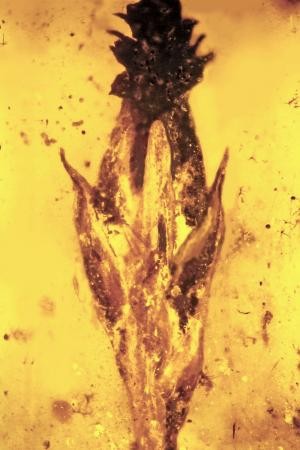Study: Dinosaurs Got High on Eating 100 Million Year-old Psychedelic Fungus
| Ana Verayo | | Feb 12, 2015 08:24 AM EST |
(Photo : Oregon State University) This grass spikelet from the middle Cretaceous is about 100 million years old, preserved in amber as the earliest fossil ever found of the evolution of grass, and covered on its tip by the parasite ergot.
Prehistoric dinosaurs apparently munched on an ancient fungus whose psychedelic properties made them high.
This was proven by a 100 million year-old amber fossil of an ancient grass, the oldest grass specimen found to date. This evidence was uncovered in a mine in Myanmar by paleontologist Joerg Wunderlich.
Like Us on Facebook
This grass was apparently covered by a fungus similar to ergot, which is poisonous but also has mind altering effects on animals that feed on it.
Ergot possesses over 1,000 compounds. It can be used for medicinal purposes but is also often misused, causing tragic events in human history such as thousands of deaths in the Middle Ages. It's even been blamed for the Salem witch trials in the U.S.
Ergot is also used to speed-up labor and induce abortion. It's also been used used along with lysergic acid diethylamide (LSD), which is an illegal recreational drug.
The fungus found in the ancient grass specimen has long been extinct and was named Palaeoclaviceps parasiticus. This particular fossil discovery suggests the fungus on the grass was devoured by dinosaurs during prehistoric times.
The fossil indicates the grass existed some 100 million years ago during the mid \-Cretaceous Period where dinosaurs roamed and conifers covered the land. This is also the time when flowering plants were beginning to evolve.
These primitive grasses evolved along with dinosaurs from evidence found on dinosaur droppings and in pieces of amber that strongly suggest psychedelic grasses existed during the Cretaceous period.
Dinosaurs such as the large sauropods, the largest among the plant eating reptiles, have feasted on the fungus they apparently found appetizing. This may have caused hallucinations and convulsions and even delirium and gangrene in other animals.
Researchers are still finding out the effects of the fungus on these ancient animals. According to George Poinar, Jr. of Oregon State University's College of Science, this is a pivotal discovery since it helps scientists determine the timeline of grass evolution, which is the basis of human food crops like corn, rice and wheat.
TagsStudy: Dinosaurs Love to Eat 100 Million Year Old Psychedelic Fungus to Get High, Dinosaurs, ancient fungus psychedelic grass LSD dinosaurs, fossil amber fungus grass LSD dinosaurs, Cretaceous period
©2015 Chinatopix All rights reserved. Do not reproduce without permission
EDITOR'S PICKS
-

Did the Trump administration just announce plans for a trade war with ‘hostile’ China and Russia?
-

US Senate passes Taiwan travel bill slammed by China
-

As Yan Sihong’s family grieves, here are other Chinese students who went missing abroad. Some have never been found
-

Beijing blasts Western critics who ‘smear China’ with the term sharp power
-

China Envoy Seeks to Defuse Tensions With U.S. as a Trade War Brews
-

Singapore's Deputy PM Provides Bitcoin Vote of Confidence Amid China's Blanket Bans
-

China warns investors over risks in overseas virtual currency trading
-

Chinese government most trustworthy: survey
-

Kashima Antlers On Course For Back-To-Back Titles
MOST POPULAR
LATEST NEWS
Zhou Yongkang: China's Former Security Chief Sentenced to Life in Prison

China's former Chief of the Ministry of Public Security, Zhou Yongkang, has been given a life sentence after he was found guilty of abusing his office, bribery and deliberately ... Full Article
TRENDING STORY

China Pork Prices Expected to Stabilize As The Supplies Recover

Elephone P9000 Smartphone is now on Sale on Amazon India

There's a Big Chance Cliffhangers Won't Still Be Resolved When Grey's Anatomy Season 13 Returns

Supreme Court Ruled on Samsung vs Apple Dispute for Patent Infringement

Microsoft Surface Pro 5 Rumors and Release Date: What is the Latest?










